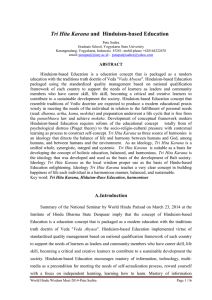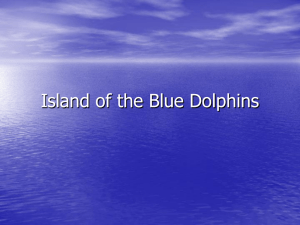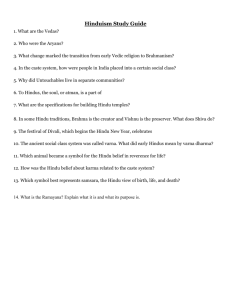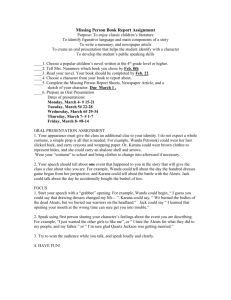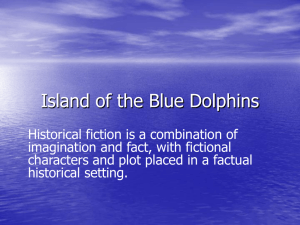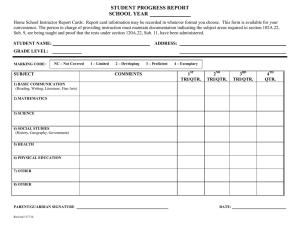World Hindu Wisdom Meet (WHWM) 2014 Hinduism-Based Education
advertisement
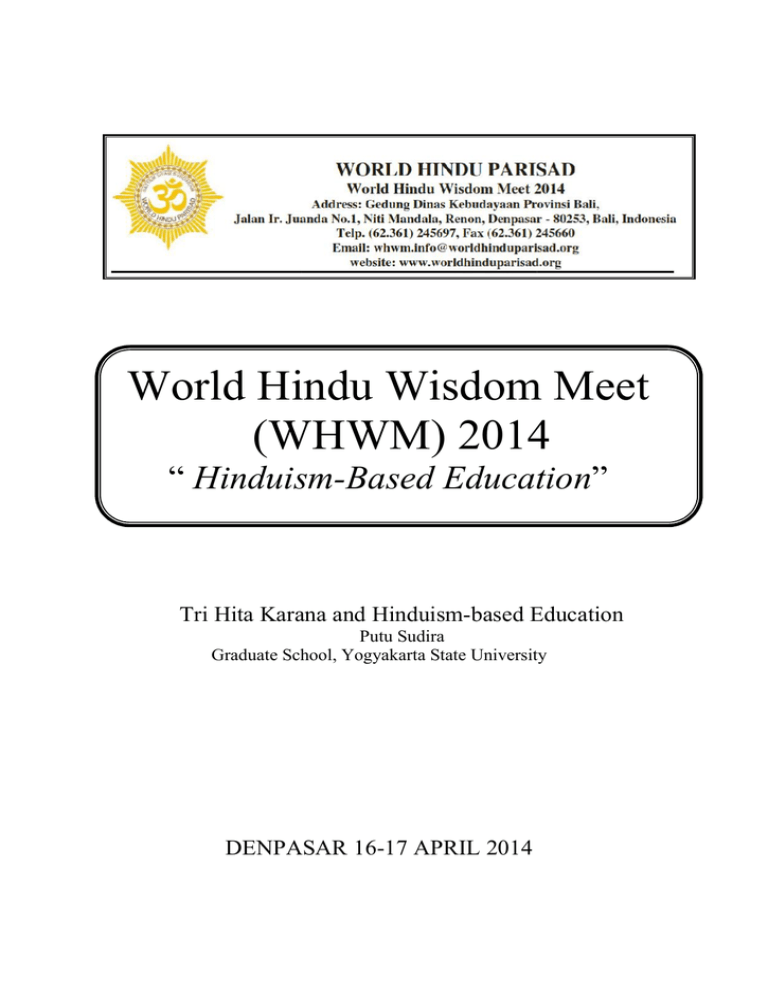
World Hindu Wisdom Meet (WHWM) 2014 “ Hinduism-Based Education” Tri Hita Karana and Hinduism-based Education Putu Sudira Graduate School, Yogyakarta State University DENPASAR 16-17 APRIL 2014 WORLD HINDU PARISAD Sekretariat : Gedung Dinas Kebudayaan Provinsi Bali, Jalan Ir. Juanda No.1 Niti Mandala Renon, Denpasar 80253, Bali, Indonesia Telp. 0361-245697 Fax 0361-245660 E-mail: info@worldhinduparisad.org / secretariat@worldhinduparisad.org website: www.worldhinduparisad.org Denpasar, 17 Pebruari 2014 No Lamp Prihal : 1717.6/WHP/ II/2014 : 1 (gabung) : Permohonan sebagai Narasumber Kepada Yth Bapak Dr. I Putu Panji Sudira, M.P Di – Tempat Om Swastyastu, World Hindu Parisad (WHP) akan meyelengarakan World Hindu Wisdom Meet (WHWM) 2014 yang akan di selenggarakan tanggal 16 – 17 April 2014 dengan tema “ Hinduism-Based Education”. Untuk menyukseskan acara tersebut maka World Hindu Parisad akan menyelenggarakan Seminar Pendidikan dengan topik ”Konsep dan Praktek Pendidikan Berbasis Hindu di Indonesia” dengan tujuan menggali konsep-konsep pendidikan Hindu yang akan dipresentasikan pada World Hindu Wisdom Meet dan selanjutnya akan menyusun rencana pengembangan dan peningkatan kualitas pendidikan berbasis Agama Hindu di Indonesia Berkaitan dengan acara seminar tersebut kami mohon dengan hormat kesediaan Bapak sebagai narasumber dalam seminar yang akan dilaksanakan pada: Hari / Tanggal : Minggu , 23 Maret 2014 Tempat : Gedung Auditorium IHDN Denpasar Jl. Ratna No. 51 Denpasar Waktu : 08.00 WITA – selesai Demikian surat permohonan ini kami sampaikan, Atas perhatian dan perkenan dari Bapak kami ucapkan terimakasih. Om, Shanti, Shanti, Shanti, Om WORLD HINDU PARISAD World Hindu Wisdom Meet 2014 Address: Gedung Dinas Kebudayaan Provinsi Bali, Jalan Ir. Juanda No.1, Niti Mandala, Renon, Denpasar - 80253, Bali, Indonesia Telp. (62.361) 245697, Fax (62.361) 245660 Email: whwm.info@worldhinduparisad.org website: www.worldhinduparisad.org No : 01/WHP/10/IV/2014 Lamp : Prihal : Permohonan Sebagai Pembicara dalan WHP & WHW Meet 2014 Kepada Yth Dr. Putu Sudira, M.P. Di Tempat Dengan Hormat, Dalam rangka kegiatan World Hindu Parisad dan World Hindu Wisdom Meet 2014. Oleh karena itu demi kelancaran acara tersebut kami mohon kesediaan Bapak untuk menjadi pembicara Internasional mewakili Indonesia pada acara tersebut dengan Topic “Concepts And Practices Of Hindusm Based Education In Indonesia”. yang akan diselenggarakan 2 (dua) hari pada: Tanggal Pkl Tempat : 16-17 april 2014 : 08.00 – selesai : Gedung Ksirarnawa, Taman Budaya Denpasar, Bali Demikianlah permohonan kami sampaikan, atas perhatian dan kerjasamanya yang baik kami ucapkan terimakasih. Om Santhi, Santhi, Santhi om World Hindu Parisad President World Hindu Parisad Secretary General World Hindu Parisad Ida Pedanda Gede Ketut Sebali Tianyar Arimbawa Prof. Dr . I Made Bakta, Sp.PD (Khom) Tri Hita Karana and Hinduism-based Education Putu Sudira Graduate School, Yogyakarta State University Karangmalang, Yogyakarta, Indonesia 55281- mobil-phone +628164222678 email: putupanji@uny.ac.id – putupanjisudira@yahoo.com ABSTRACT Hinduism-based Education is a education concept that is packaged as a modern education with the traditions truth doctrin of Veda "Veda Abyasa". Hinduism-based Education packaged using the standardized quality management based on national qualification framework of each country to support the needs of learners as leaders and community members who have career skill, life skill, becoming a critical and creative learners to contribute to a sustainable development the society. Hinduism-based Education concept that resemble traditions of Vedic doctrine are expected to produce a modern educational praxis wisely in meeting the needs of the individual in relation to the fulfillment of personal needs (read: dharma, artha, kama, moksha) and preparation underwent a life cycle that is free from the punarbhawa law and achieve moksha. Development of conceptual framework modern Hinduism-based Education requires reform of the educational concept totally from of psychological distress (Piaget theory) to the socio-religio-cultural pressure with contextual learning as process to construct self-concept. Tri Hita Karana as three source of harmonies is an ideology that directs the balance of life and harmony between humans and God, among humans, and between humans and the environment. As an ideology, Tri Hita Karana is a unified whole, synergistic, integral and systemic. Tri Hita Karana is suitable as a basis for developing the concept of holistic education, balanced, and harmonious. Tri Hita Karana is the ideology that was developed and used as the basis of the development of Bali society. Ideology Tri Hita Karana as the local wisdom proper use as the basis of Hindu-based Education enlightening. Ideology Tri Hita Karana teaches a very clear concept in building happiness of life each individual in a harmonious manner, balanced, and sustainable. Key word: Tri Hita Karana, Hiduism-Base Education, harmonious A.Introduction Summary of the National Seminar by World Hindu Parisad on March 23, 2014 at the Institute of Hindu Dharma State Denpasar imply that the concept of Hinduism-based Education is a education concept that is packaged as a modern education with the traditions truth doctrin of Veda "Veda Abyasa". Hinduism-based Education implemented virtue of standardized quality management based on national qualification framework of each country to support the needs of learners as leaders and community members who have career skill, life skill, becoming a critical and creative learners to contribute to a sustainable development the society. Hinduism-based Education encourages mastery of information, technology, multimedia as a precondition for meeting the needs of self-actualization process, reward yourself with a focus on independent learning, learning how to learn. Mastery of information World Hindu Wisdom Meet-2014-Putu Sudira Page 1 /16 technology makes learners are able to learn from various sources that are not limited contents, space, place, and time over a computer network. Learning intelligence led to the development of high level skills of critical thinking, creative, communicate, collaborate. There are two Vedic tradition teachable i.e: Para Vidya (spiritual knowledge) and Apara Vidya (worldly knowledge). Doctrins of Vedic important to practiced in Hinduismbased Education are: (1) Dewa Abhimana is a devotion sense (bhakti) to God; (2) Dharma Abhimana is love and determination sense holding the truth of Vedic (Dharma); (3) Viveka is the abilities to think analytically-synthesis; (4) Karma Siksana means action fix immoral behavior; (5) Satsila means to build a noble character; (6) Desa Abhimana means spirit to motivate themselves to serve the homeland; (7) Subha Sita Veda means diligently studied the wise words of Hindu leaders who come from the doctrins of the Vedic scriptures (Wiana, 2014). Hinduism-based Education concept that resemble traditions of Vedic above are expected to produce a modern educational praxis wisely in meeting the needs of the individual in relation to the fulfillment of personal needs (read: dharma, artha, kama, moksha) and preparation underwent a life cycle that is free from the punarbhawa law and achieve moksha. Development of conceptual framework modern Hinduism-based Education requires reform of the educational concept totally from of psychological distress (Piaget theory) to the socio-religio-cultural pressure with contextual learning as process to construct selfconcept. So pragmatically, Hinduism-based Education concept progressive to changes of the new global education paradigm. Sri Sultan Hamengku Bhuwuno X the king of Kasultanan Ngajogjakarta Hadiningrat, in ceremony 49th Anniversary Yogyakarta State University said "Education is the process that drives all the liberating forces of the human from crush of poverty, unemployment, ignorance, backwardness, social and culture chaos, fear, stress, and all forms of dependence. On the other hand the leading education figures John Dewey stated that education is a process that is geared towards fulfilling the needs of individuals in relation to personal fulfillment and preparation underwent life cycle. Word of Sri Sultan Bhuwono X and John Dewey can be used as a hint that Hinduismbased Education should be able to brighten people to find a liberating force. Hinduism-based Education concept includes a holistic process of planting moral values and attitude in the process of achieving self reality by optimizing all of potential learners and the aspects of contextual educational environment. Morally Hinduism-based Education should be able to make the Veda as a spiritual power to overcome the anguish and anxiety of life. Veda used as World Hindu Wisdom Meet-2014-Putu Sudira Page 2 /16 way of life that integrated in each individual person as a tradition mentioned above. Because personality that will control the people in his life. Veda it must be received by thoughts or feelings (consciously or unconsciously) and implemented as a tradition or habits in daily life in the community. This principle contains a very broad scope of meaning in the perspective of education both as a process of learning, philosophical meaning, religiosity, psychological, and sociological. Hinduism-based Education is expected to address the issue agony and anxiety of life. People who are not agitated and inner calm is one of the characteristics of people can develop a healthy and happy life. Another feature of the happy healthy person stated by Prof. Dr. Ida Bagus Mantra. In the view of Prof Dr. Ida Bagus Mantra Hindu human resources will be able to exist if it has three advantages that a balanced and synergistic. The third seed is: (1) physically healthy; (2) quiet in spiritual (rokhaniah); (3) professional or have the skills or expertise. These advantages can be achieved through proper education Hinduism. Hindu Religious Education establish a moral virtue and mental strength of the students to have the toughness to deal with the dynamics of life in the world (Wiana, 2014). Hindu-based Education in the process of finding an enlightening liberating force, requiring the whole educational process. Hindu-based education developed comprehensively in schools, families, and communities. This kind of education requires a holistic concept of education foundation in building a balanced life of happiness through formal education in schools, non-formal education in the community, and informal education in the family. Sudira research found that the ideology of Tri Hita Karana (THK) is suitable as a basis for developing the concept of holistic education, balanced, and harmonious. Tri Hita Karana is the ideology that was developed and used as the basis of the development of Bali society. Ideology Tri Hita Karana (THK) as the local wisdom proper use as the basis of Hindu education enlightening. Ideology THK teaches a very clear concept in building happiness of life each individual in a harmonious manner, balanced, and sustainable. This paper discusses the conceptual framework of THK as the Hinduism-based Education. B.Tri Hita Karana Historically, ideology of Tri Hita Karana first was raised on November 11, 1966, at the First Regional Conference, Balinese Hindus Struggle Agency housed in Dwijendra University Denpasar-Bali (Bali Galang Foundation 2000-2003). The conference was held by consciousness Hindus people will participate in the development of the nation toward a World Hindu Wisdom Meet-2014-Putu Sudira Page 3 /16 society prosperous, equitable, and prosperous based on Pancasila. THK ideology coined by Dr. I Wayan Mertha Suteja and later popularized by Mr. I Gusti Ketut Kaler and Mr I Made Djapa, BA [11]. THK ideology, is the synthesis of the concept of the Java Community "cucupu lan manik". This concept is based on the values of harmony and balance between container "cucupu" with the contents "manik". This concept is often illustrated as a baby in the womb or uterus of the mother. Baby grows in the womb of the mother is perfect because there is harmony. Humans are the contents "manik" and the universe are the container "cucupu". The happiness of life in the universe can be achieved if humans can develop harmony and balance together societies and the universe. Synthesis of the concept of "cucupu lan manik" later developed as THK. THK is one of the indigenous wisdom Balinese people. THK implies three causes of prosperity and happiness that comes from the harmonious relationship: (1) man and God called Parhyangan; (2) between man and his neighbor called Pawongan, (3) between humans and the nature called Palemahan. Harmony means doing things that contain the goodness, the holiness which starts from the mind, spoken in words, and is seen in action (Raka Santeri, Kompas: December 5, 2007). Harmony of thought, word, and deed according Gede Prama is the beauty of life (Bali Post, October 3, 2008) [11]. Lexically, Tri Hita Karana means three causes of well-being and happiness. Tri means three; Hita means to live a prosperous, happy, sustainable; Karana means cause. Tri Hita Karana means three causes of happiness and well-being. THK ideology developed from the humanity of human concept. THK concept is very clear and comprehensive. THK concept states: micro in humans there are three basic elements of the cause of a happy prosperous life. These three basic elements of the human causes of a happy prosperous life is: (1) the soul/Atman/spirit; (2) the physical body/angga sarira; (3) life force (prana). The third basic elements is THK or the three cause of human life in happy and prosperous. Basic requirements that must be met in building happiness is a balance and harmony between these three basic elements. These three basic elements possessed by every human being. Happiness can be cultivated by humans during their life. THK concept in human micro system as illustrated in Figure 1 below. World Hindu Wisdom Meet-2014-Putu Sudira Page 4 /16 Figure 1. Micro System Tri Hita Karana In Widhi Tatwa or philosophy of divinity states that every human being has three basic elements of capital of happiness are: (1) Atman/soul/spirit; (2) the physical body; and (3) prana/power of life. Soul/spirit, physical body, prana (power of life) is three (Tri) basic elements of the cause (Karana) that humans achieve happiness (Hita) so-called "Tri Hita Karana" (see Figure 1). According Agastia (2007), in Widhi Tatwa stated that the entry of the soul/spirit into the human body (physical body) generate prana or power of life in the form of sabda, bayu, idep. It is identical to install software into the computer hardware that makes the computer has power operation. If the software is not installed into the computer hardware does not function at all. Among the software and hardware to be suitable or appropriate. Software that does not match the hardware or software that many infected viruses cause work power of the computer will be disrupted even does not work at all. THK ideology states that happiness in life, caused by the presence of three main elements, namely: (1) the soul/spirit, (2) physical/body, and (3) prana. The third element of this life, ie: soul, physical, and prana is the THK. Happiness or harmony of life (hita) can be achieved when there are three causes (tri karana) is the soul, the body/ physical, and prana. The soul is the abstract or software of human element. Body, with all physiological organ is an element of human physical or hardware. The entry of the soul into the human body, awaken vitality, in the form of active ability (bayu), the ability to think (idep), communication skills (sabda). World Hindu Wisdom Meet-2014-Putu Sudira Page 5 /16 Loss of one of the three causes of happiness will negate happiness. Physical body without the soul is dead that will not be able to do anything about it. Soul without a body is a ghost who can not act anything. Body with a soul, without power is a creature that is a burden of life [11]. The three capital to happiness, the soul, the physical body, and the power should be balanced and harmonious life. Development of the third capital of human happiness can be done through education. Education is an important part of the process of developing awareness of the human soul. Understanding of the physiology of the human self can cause health and body fitness. Health and fitness, to be followed by health way of thinking (idep) by always thinking positive. A healthy and fit body, causing many human minds can act and do what is productive and enjoyable for others. THK elements in the macrocosm and microcosm were the same. In microcosm there are three main elements, namely: (1) the soul/spirit, (2) physical/body, and (3) prana. In the macrocosmic, soul element (parhyangan) in man is manifested in the form of temples. Building temples can be found in schools, in the family home, and in pakraman village. Body element (palemahan) in the microcosm man transformed into an area of land and school buildings, grounds and building area of the family home, and area boundaries as well as various buildings in pakraman village. While the prana element in human beings who later became pawongan at school realized in the form of students, teachers, education staff, member family consisting of father, mother and child, as well as community members of a region pakraman village. Harmony of man's relationship with God can be realized in the forms of worship activities, prayers, ceremonies held at the temple school, family temple (sanggah/pemerajan), and in the kahyangan tiga temple in pakraman village. Harmony relationships with fellow human beings can be realized in the form of socio-cultural activities, creative economic development, people's economy through agriculture, plantation, animal husbandry, fisheries, handicrafts, preservation of family values and mutual support, learning together, helping each other. Harmonious relationships with others do well in school, in the family, and in society of pakraman village. Harmonious relationship between man and nature can be realized by way of environmental preservation, planting and caring for trees, forest preserve, maintain cleanliness of rivers, lakes, springs resources, caring for the coast, irrigation channels. Worship of God, environmental conservation, and development of harmonious life with happiness and always within the framework of collective survival. World Hindu Wisdom Meet-2014-Putu Sudira Page 6 /16 As social beings, THK basic concepts in human beings that comprise the soul/spirit, physical body, and the life force then developed and expanded in the institutional arrangements in the family and in the community with the following pattern: (1) the soul/ spirit man becomes a holy place called Parhyangan; (2) the physical body human becomes a land of life called Palemahan; (3) the power of human life that is the sabda, bayu, idep becomes force of society called Pawongan. THK patterns in the composition of the microcosm and the macrocosm of the human person in the institution of school, family, and society depicted in Figure 2 below. The MAPPING of CONCEPT THK & THREE PILLARS of EDUCATION in BALI MICRO HUMAN MACRO SCHOOL PRAHYANGAN PAWONGAN School Temple Soul PRANA PALEMAHAN Body Teachers Student Academic Staff School Building Area FAMILY Family Temple SANGGAH PEMERAJAN COMMUNITY Pakraman Village temple Father- Mother Soon Village Community Family Building Area Community Building Pakraman Village Figure 2. THK Patterns In Microcosm And Macrocosm source: Sudira, 2013 Based on the concept of Figure 2 above, the spirit or soul (soul) of man is Prahyangan as a shrine or associated with sanctity. In schools, the holy place or the soul of the school is school temple. In the family, the family shrine or soul of family is family temple called Sanggah or Pemerajan. In Pakraman village, shrine or soul of pakraman village is Pakraman Vilage temple like Kahyangan Tiga i.e. Pura Desa, Pura Puseh, and Pura Dalem. THK concept suggests that each school, family, and pakraman vilage should have a shrine or temple. If not, then just as with humans who do not have a soul presumed dead. World Hindu Wisdom Meet-2014-Putu Sudira Page 7 /16 Power of life or prana "sabda, bayu, idep" in the micro man becomes pawongan. Pawongan in the School institute consists of components educators, staff, students, school committees, school support personnel. In the family institution pawongan element consists of a mother, father, and child. In Pakraman village, pawongan element consists of all members of the Pakraman village. THK concept clear seat that educators, staff, students, school committees, school support personnel; mother, father, and child in the family; all members of the village residents are power of life a society. As the power of life of all pawongan components must be educated and conscious in THK. C.The Tri Hita Karana Unsure a. Parhyangan Parhyangan is an unsure of the THK that regulates human life balance concept with the creator God. In man there is the soul as the core subject of life. Education that builds awareness of the human soul can recognize who led him, what is the nature, vision, and mission in life. Education for the development of soul consciousness can build mental and moral strength. Within the family, community of pakraman village, and schools, parhyangan manifested in the form of temples. In the family home called Sanggah/Pemerajan. In the pakraman village called Kahyangan Tiga. In Schools called School temple. Tempel serves as a place to worship of God, to preserve arts and cultural values of Hinduism. The existence of the temple can improve the integration of the mindset and attitude of living a clean and healthy body, faceful spiritual. The existence of the temple is also building a culture of mutual support, cooperation, devotion among others, serve each other amicably. Temple is best used as a vehicle to develop mindset and attitude to life doing good intentioned, develop creativity and innovation in the effort to create the things that should be created, maintain the things that are still relevant and necessary, nullify the things that are not relevant. The existence of pretending to be the basis of moral and mental development. In school, the temple serves as a vehicle of acculturation and enculturation cultural Hinduism. School temple serves as a vehicle for the development of emotional intelligence, spiritual, and learning. School temple can foster belief in the teachings of religion and devotion to God. Through a variety of worship activities in the schools temple, students and teachers develop a culture of mutual service, togetherness, mutual respect, self-eliminating selfishness, change the properties exclusive to the integrative properties. School temple functioning build moral strength and mental fortitude for students and teachers. World Hindu Wisdom Meet-2014-Putu Sudira Page 8 /16 b. Pawongan Pawongan is the second element of THK which regulates the concept of balance and harmony among humans. Life balance and harmony among humans will work well if every human being develops its three capital of prana. Three human prana that is: (i) Idep as the ability to thinking critically, creative, and imaginative; (ii) Sabda as the ability to communicate to build a good relationships with others, (iii) Bayu as the ability to act professionally and independently in solving the problems. Man in the THK perspective is the key sustainable development education. Central tenet of harmonious living among humans is "Tri Kaya Parisudha and Tri Pararta". Tri Kaya Parisudha teaches people to think good and right, speak properly, act properly. Tri Pararta teaches that this life must be built on the love, the sacrifice of one another, genuinely sincere service. Tri Kaya Parisudha and Tri Pararta is the moral bases of the Hinduism Education, which needs to be fostered in the every individual through education. Invesment of Tri Kaya Parisudha and Tri Pararta in human individual will develop the ability to be more creative in solving life problems and to realize life together in mutual cooperation. THK man who has developed the perfect "prana" in him will be supporting a culture of life balanced and harmonious in the Hinduism-based Education. Man who has grown all the THK element is part of the family and society in Pakraman village as capital Hinduism-based Education. In stages, people in the family and in the community can develop the social and economic potential balanced. Doctrine is used as the basis is Tri Warga namely dharma, artha, kama. Human is right to fulfill their wants and needs (kama) to acquire wealth (artha), but must be based on truth and the laws of the natural universe (dharma and rta). Structuring pawongan in establishing harmony among humans can support the development of the mindset and attitude of tolerance, civility, love without violence, responsibility, commitment, hard work by continuing to foster a culture of learning, work culture, and the culture minister. Development of harmony and happiness includes two things: "janahita" means happiness individually, and "jagathita" is happiness together. This is what should be developed by people across the world. Balinese local knowledge associated with janahita and jagathita in education for the world of work is "ngalih gae pang meturu idup" means looking for work in order to live together, not "mati iba idup kai" means you die my life. How the Balinese people looking for a job, build a life and a job to support the common World Hindu Wisdom Meet-2014-Putu Sudira Page 9 /16 good. Not develop ways to kill other people's lives, oppress people to live a happy life at the expense of others. Not just to save themselves, respectively. It is a form of realization of the values of social and economic justice for all people, and respect for individual diversity. c. Palemahan Palemahan is the third element of THK. Palemahan contains the concept of balance and harmony between man and the universe. This concept is closely associated with the process of saving the planet Earth through ecosystem restoration and maintenance. Palemahan concepts relating to structuring, organizing, and yard utilization of the physical environment. Values are developed healthy lifestyle, healthy, and productive with nature. Structuring, organizing, and utilization of the physical environment, their yards, according to this concept is divided into three, namely: (i) the main areas for development of the shrine (temple), (ii) the area of the center for the development of family and social activities, (iii) the area below to use the farm, raising livestock, planting, and sewage treatment. Structuring and organizing the house and yard area in Balinese schools still use this concept. This concept was developed based on the flow of water and solar energy. Mountains and the east, is a central source of flow as the main venue. The sea and the west is the direction of the shelter or contemptible. In the middle, between the mountains and the sea is the area of regional development or social activities. Micro level in man, palemahan concept relates to the physical basis of human capital with the potential of tool motion. Human life has a full body with five senses and the five-tool motion. Through the human brain can develop the potential of thinking to drive and steer the five senses and the five tool motion. Palemahan element as a third element in the concept of THK also become an integral part in the school. Structuring shade, beauty and comfort of the school with a variety of plants strongly supports the government program called the green school. Reforestation and planting of ornamental plants, has a very high value of the function. Aside from being a producer of fresh oxygen, the tree turned out to be a very good learning objects for vocational students. Plants that shade and beautiful, can make teachers and students of SMK become healthy body, and spiritual calm. Plants are very much used as an object of study. Because it is used as an object of study, the growing behavioral maintain and care. World Hindu Wisdom Meet-2014-Putu Sudira Page 10 /16 D.Tri Hita Karana in Three Pillars of Hinduism-based Education Hinduism-based Education development should take place in schools, families, and communities. School, family, and community are the three pillars of education in Indonesia. This means that education should take place in schools, in families and in society. Although Indonesia has set three essential pillars of education, but until now there is no clear division between education in schools, in families and in society. Educational practices in Indonesia intensified on only one pillar that is in school. People tend to educate their children at school only. Problems that occur in the family and in society, all brought to school. As a result, the school became overloaded in implementing educational practices. From Figure 2 above can be explained key subject of education is human, which has been developed, THK capital. As the subject of education, people should grow intact in three aspects, namely: (i) physical, (ii) viability, (iii) the soul. THK man according to Prof. Dr.. Ida Bagus Mantra is a healthy human body, spiritual calm, intelligent, and professional in carrying out his duties. THK humans have: (i) health and physical fitness are marked with normal organ function throughout the body, (ii) is able to think, communicate, and act effectively efficiently, (iii) having a clean and bright spirit. THK educational perspective should be able to encourage the growth of health and physical fitness, systemic thinking skills, ability to communicate and act effectively and efficiently. THK component in the school in the form of: (i) a school temple as parhyangan; (ii) teachers, students, employees as pawongan; (iii) the area of the school building as palemahan. In schools, teachers and students are at the core of THK, which most determine the success of Hinduism-based Education development. Schools temple should be used to educate and develop students' emotional spiritual intelligence. School temple can also be used for the development of arts and cultural intelligence. Learning is implemented in schools in order to develop the values of harmony and life balance can be done with a holistic approach to education. Students are given the experience of learning to recognize themselves as a whole starting from the appreciation of the existence of the soul in the body, then spreads out to live in the capital of physiological and psychological interactions in local, national, global and increasingly complex. Education in schools should reinforce student learning intelligence to recognize symbols, physical evidence of life (empirics), art and beauty (esthetic), shared understanding of the relational and protective care (synoetics), ethics and morality (ethics), up until the World Hindu Wisdom Meet-2014-Putu Sudira Page 11 /16 inegratif comprehensive view of life (synoptics). THK school, to build educational values of truth, loyalty, love, non-violence, civility, tolerance, honesty, discipline, responsibility, hard work in order to establish an individual who has a work culture, learning culture, and the culture of serving others. THK Schools must grow in the attitudes and mindset to work together, collaborate to solve problems creatively. The development of information technology can be utilized to improve the ability to access and utilize information from a variety of sources. By THK, education in schools to be strong based on local wisdom, open to global influence filtered. As a result, a new generation of education through THK is the generation of supporters and builders of Hinduism-based Education. Education in the family can not be ignored in the formation of the personality of students. In the family, the three elements of THK, are: (i) sanggah/pemerajan as parhyangan; (ii) the father, mother, son as pawongan; (iii) the yard and house building as palemahan. In the household or family sanggah/pemerajan is parhyangan, which serves as the soul of the family, while the family members are pawongan as prana household, and yard or area of the house is palemahan. Sanggah/pemerajan as parhyangan is the soul, protector, guide for all family members. In sanggah/pemerajan God worshiped as Lord Guru who has the power to guide family members to be intelligent, skillful, wise, and thoughtful. The word "guru" means lightening, darkness to light glowing transformer. Happiness in the home is the embodiment of harmony between family members (grandfather, grandmother, mother, father, child, grandchild), harmonization between family members with sanggah/pemerajan, and harmonization between the family members and a neighborhood full of houses with plants and animals. Home according to the Balinese not only as a resting place (house) but a home environment conditioned, full of cultural values, a venue for the educational process, development and acculturation the balanced of life. To achieve happiness in the family, it takes self harmony on each individual member of the family. Besides, it is also necessary harmony between the individual members of the family; harmony each individual with parhyangan, and harmony individual family members with palemahan. Disharmony one element in THK will disrupt family harmony. It would require the development of religious values, honesty, truth, righteousness, peace, love, non-violence, hard work, caring, responsibility. Families is an agencies development of individual THK. Family put individualization process as a specific process development of of various forms of THK capital in the form of World Hindu Wisdom Meet-2014-Putu Sudira Page 12 /16 spiritual ability, the ability to sense/ratios, emotional skills, physical abilities. THK capital can develop if integrated with other members of the family (pawongan). Interaction means opening oneself to others. In the process of opening up there are two possibilities that could happen is harmony or conflict within the man himself. THK ideology teaches that the individualization process that requires the balancing interaction between man with God (parhyangan) and the environment of palemahan through participation [11]. The third pillar of education is the society environment. Pakraman village society constitute union community has he third pillar of education is society. Pakraman community in Bali is one unit that has a community of customs and traditions are governed by certain rules called awig-awig. Educational success in school and in the family will be tested in the community. Ability to apply the results of education in society, a measure of educational success. Community is the best place to do education. Hinduism-based Education should theoretically based society. E.Tri Hita Karana Morality in Hinduism-based Education Morality is a system of rules and actions that predetermine conduct. An essential element of morality is the spirit of discipline, which in turn presupposes the existence of organization and authority [1]. Morality may best be understood as relating just to the actions of individuals, groups, organizations or governments, and as requiring both an intention to act in the interests of the well-being of persons affected by it, and that the action be informed by an understanding of what it means to act in that way (Bagnall, Jarvis) in Richard G. Bagnall (2009; p. 2164). Moral beliefs which may be powerful forces in altering individuals’ attitudes towards children and formulating justifications and explanations for their behaviour in relation to them, may, according to this vision of society, also change society in certain preferred directions [6]. THK morality is the spirit of Balinese society to act discipline according the vision happiness in life come from harmonious relationship: (1) man and God called Parhyangan; (2) between man and his neighbor called Pawongan, (3) between humans and the natural world called Palemahan. This morality change society committed to build human and nature between generations, always respecting diversity and continue to do ecosystem restoration; tolerance towards all beings by practicing non-violent attitudes and social identity as a peaceloving society. Values of SVE ie: respect for the dignity and human rights; harmonious life World Hindu Wisdom Meet-2014-Putu Sudira Page 13 /16 with social and economic justice for all people. Development of harmony and happiness includes two things: "janahita" means happiness individually, and "jagathita" is happiness together. This is what should be developed by people across the world. Balinese local knowledge associated with janahita and jagathita in education for the world of work is "ngalih gae pang meturu idup" means looking for work in order to live together, not "mati iba idup kai" means you die my life. How the Balinese people looking for a job, build a life and a job to support the common good. Not develop ways to kill other people's lives, oppress people to live a happy life at the expense of others. Not just to save themselves, respectively. THK morality has a rational basis and develops through an internally directed process of constructing increasingly sophisticated understandings about the inherent logic of social relations. Moral development comes about as people, in their interactions with other people, increasingly grasp “the permanent laws of rational cooperation” [7]. Balinese community develop the social and economic potential balanced with the doctrine Tri Warga namely dharma, artha, kama. Human is right to fulfill their wants and needs (kama) to acquire wealth (artha), but must be based on truth and the laws of the natural universe (dharma and rta). THK as the basis of morality in Hinduism-based Education build a culture of mutual support, cooperation, devotion among others, serve each other amicably. Temple is best used as a vehicle to develop mindset and attitude to life doing good intentioned, develop creativity and innovation in the effort to create the things that should be created, maintain the things that are still relevant and necessary, nullify the things that are not relevant. The existence of pretending to be the basis of moral and mental development strengthening Hinduism-based Education. F. Conclussion Hinduism-based Education is a education concept that is packaged as a modern education with the traditions truth doctrin of Veda "Veda Abyasa". Hinduism-based Education concept that resemble traditions of Vedic doctrine are expected to produce a modern educational praxis wisely in meeting the needs of the individual in relation to the fulfillment of personal needs (read: dharma, artha, kama, moksha) and preparation underwent a life cycle that is free from the punarbhawa law and achieve moksha. Hinduism-based Education concept used ideology of Tri Hita Karana can fostering student in devotion sense (bhakti) to God, love and determination sense holding the truth of Vedic (Dharma), abilities to think analytically-synthesis, action fix immoral behavior, to build a noble character, spirit to World Hindu Wisdom Meet-2014-Putu Sudira Page 14 /16 motivate themselves to serve the homeland, diligently studied the wise words of Hindu leaders who come from the doctrins of the Vedic scriptures. "Janahita" as happiness individually and "jagathita" as happiness together is morality of Tri Hita Karana in developing sustainable Hinduism-based Education. Human in fulfill their wants and needs (kama) to acquire wealth (artha) must be based on truth and the laws of the natural universe (dharma and rta). Tri Hita Karana as three source of harmonies is an ideology that directs the balance of life and harmony between humans and God, among humans, and between humans and the environment. As an ideology, Tri Hita Karana is a unified whole, synergistic, integral and systemic. Tri Hita Karana is used as the basis for the management and development of Balinese culture. When seen as offering an approach to the development of Hinduism-based Education, Tri Hita Karana directs the moral foundation of sustainable education in local, national, regional and global contexts. Tri Hita Karana also provides core values as a moral foundation in vocational education to strengthen the integrity and identity of the Indonesian people in building a sustainable vocational education as part of the sustainable development. REFERENCES [1] Agastia, I.B.G. (November 2007). Mengkritisi impelemtasi tri hita karana. Warta Hindu Dharma, 491, 40-41. [2] [3] [4] [5] [6] [7] [8] [9] [10] [11] Bagnal, R. “ The ethics of tvet policy and practice: issues of access and quality”. International handbook of education for the changing world of work, bridging academic and vocational learning. Ed. R. Maclean, D. Wilson, & C. Chinien. Bonn: Springer Science Business Media B.V., 2009. 2163-2176. Djohar,. Reformasi dan masa depan pendidikan di Indonesia. Yogyakarta: IKIP Negeri Yogyakarta, 1999. Djohar, Budaya lokal sebagai basis pendidikan, Makalah seminar di Percetakan Kanisius Yogyakarta, (2008). King, M. A better world for children? explorations in morality and authority. New York: Taylor & Francis e-Library., 2002. Mosman, D. Adolescent rationality and development; cognition, morality, and identity. New York: Taylor & Francis Group., 2011. Pavlova, M. Technology and vocational education for sustainable development empowering individuals for the future. Queensland: Springer Science Business Media B.V., 2009. Sudira, P. Praxis of the tri hita karana ideology in competence cultivation in bali;s vocational high school. Yogyakarta: Dissertation., 2011. Sudira, P. Praksis tri hita karana dalam pembudayaan kompetensi pada SMK di Bali, Disertasi: Program Pascasarjana Universitas Negeri Yogyakarta, 2011. Sudira, P. Paradigma pendidikan berbasis tri hita karana, Majalah Hindu Raditya, 2011. Sudira, P. Revitalisasi pembelajaran pendidikan agama hindu, Majalah Hindu Raditya, 2011. World Hindu Wisdom Meet-2014-Putu Sudira Page 15 /16 [12] [13] Sudira, P. Reconceptualization Vocational Education and Training in Indonesia based-on “Wiwekasanga”: Proceeding; International Conference VTE The Roles of Vocational Education in The Preparation of Professional Labor Force, 2011. Sudira, P. Praksis tri hita karana dalam struktur dan kultur pendidikan karakter kejuruan pada SMK di Bali: Jurnal Pendidikan Karakter, Universitas Negeri Yogyakarta, 2011. [14] [15] [16] [17] Sudira, P. Pendidikan Kejuruan Dan Vokasi Berbasis Tri Hita Karana: Proseding Kongres Pendidikan dan Pengajaran UGM, 2012. Sudira, P. SMK Kearifan Lokal Tri Hita Karana. Jurnal ADGVI Vol. 2 No. 2: Program Pascasarjana UNY, 2012. Sudira, P. “Tri Hita Karana” and the Morality of Sustainable Vocational Education: Proceeding International Seminar The 8th Asia Pacific Network for Moral Education, Yogyakarta State University, Indonesia, 2013. Sudira, P. Indigenous Wisdom Tri Hita Karana dan Pengembangan SDI Melalui SMK: Proseding LPPM UNY, 2013. [18] [19] [20] Sudira, P. Pendidikan menabur nilai luhur panen karakter “mikul duhur mendem jero, Majalah Hindu Raditya, 2012. Tilaar, H.A.R., Pendidikan Kebudayaan, dan Masyarakat Madani Indonesia. Bandung: PT. Remaja Rosdakarya, 1999. Tilaar, H.A.R., Perubahan Sosial dan Pendidikan, Pengantar Pedagogik Transformatif untuk Indonesia. Jakarta: PT. Gramedia, 2002. [21] Wastika, D.N. (2005). Penerapan Konsep Tri Hita Karana Dalam Perencanaan Perumahan di Bali. Jurnal Permukiman Natah Vol. 3 No. 2, 62 – 105. [22] Wiana, IK., (29 November 2003). Kewajiban Utama Desa Pakraman Menegakkan Tattwa. Diunduh pada tanggal 12 Oktober 2010, dari http://www.iloveblue.com/bali_ gaul_funky/artikel_bali/category/KETUT%20WIANA/10/13.htm [23] Wiana, IK., (20 Juli 2009). Membenahi Motivasi Kerja. Diunduh pada tanggal 2 Juni 2010, dari http://www.iloveblue.com/bali_gaul_funky/ artikel_bali/detail/2820.htm [24] Wiana, IK., (8 Juni 2009). Tantangan SDM Hindu kedepan. Diunduh pada tanggal 2 Jui 2010, dari http://www.iloveblue.com/bali_gaul_funky/ artikel_bali/detail/2820.htm [25] Wiana, IK., (8 Juni 2009). Kegiatan Beragama Hindu Membangun SDM Bermutu. Diunduh pada tanggal 2 Juni 2010, dari http://www.iloveblue.com/ baligaulfunky/ rtikel_bali/detail/2820.htm [26] Wiana, IK., (6 April 2009). Dosa kalau Pendidikan tanpa Karakter. Diunduh pada tanggal 2 Juni 2010, dari http://www.iloveblue.com/ baligaulfunky/ rtikel_bali/detail/2820.htm. [27] Wiana, IK, (23 Maret 2014).Melalui pendidikan Hindu membangun moral dan mental tangguh. Makalah seminar nasional World Hindu Parisad. [28] Zajda, J., Biraimah, K., Gaudelli, W.(2008) Cultural Capital: What Does It Offer Students? A CrossNational Analysis . Education and Social Inequality in the Global Culture Melbourne: Springer Science + Business Media B.V. World Hindu Wisdom Meet-2014-Putu Sudira Page 16 /16
